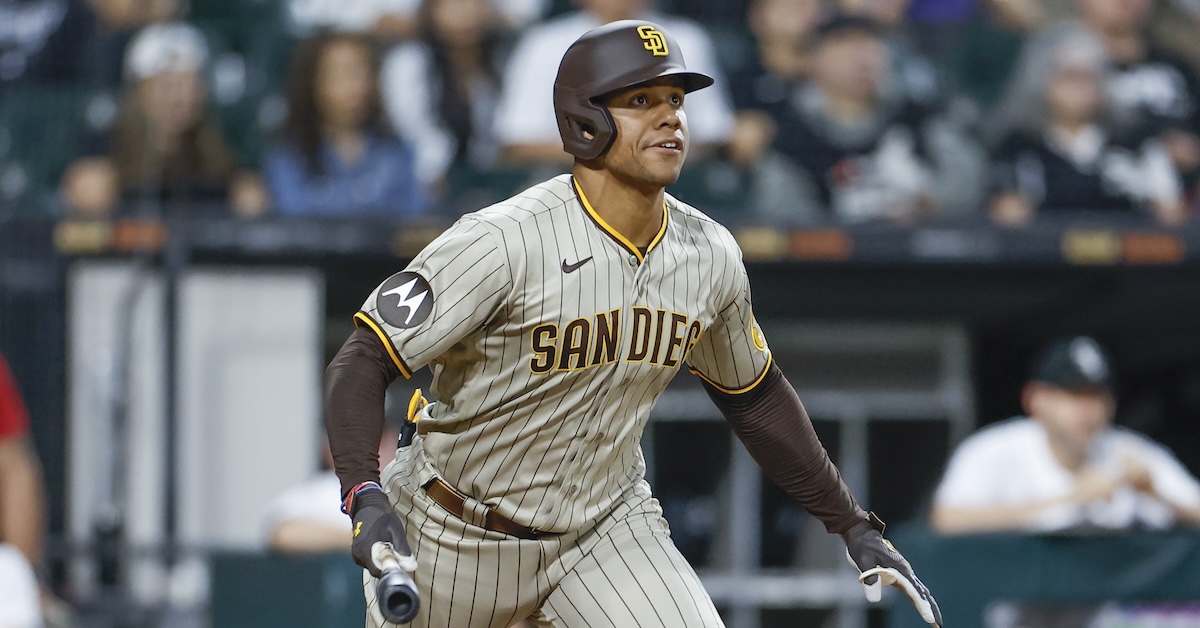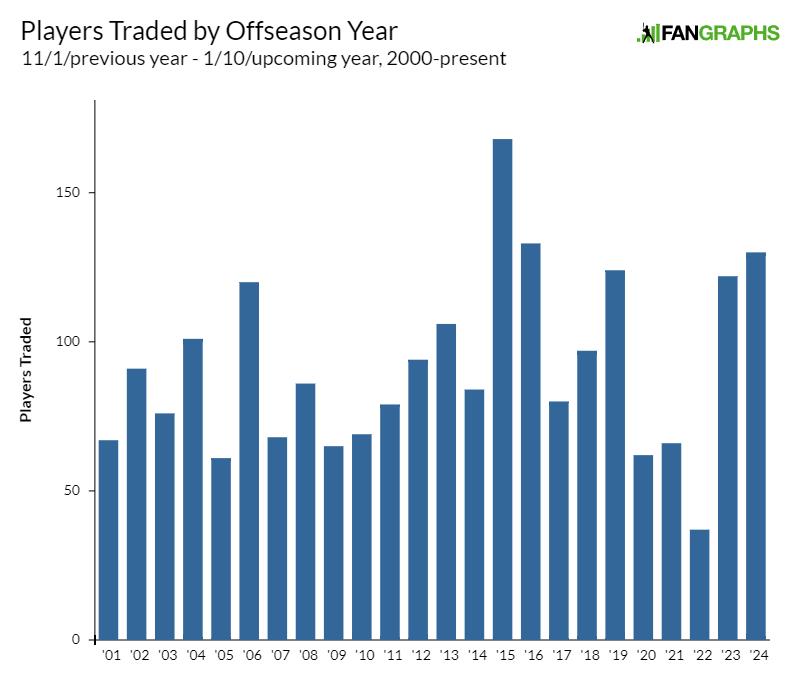
Kamil Krzaczynski-USA TODAY Sports
Every time I look up this offseason, I see a string of trades. The Braves seemingly made 65 roster moves to upgrade one position. The Mariners sent away a good chunk of their 2023 roster to save money and bulk up their outfield. The Rays are Rays’ing as hard as ever. Truly, it feels like a golden age for offseason deals.
All told, 130 players have changed teams via trade this offseason, per RosterResource. The quality is all over the map, from former Cy Young winners Chris Sale and Robbie Ray to minor leaguers you’ve never heard of. Juan Soto aside, it hasn’t been much of a season for blockbusters, at least in my estimation, but the sheer volume feels notable.
This being FanGraphs, though, I didn’t want to leave it at that. Sure, it feels like more teams than ever are engaging in red paperclip chains to make marginal upgrades, but the Rays also existed in prior offseasons, and Jerry Dipoto didn’t get his reputation for wheeling and dealing yesterday. Heck, A.J. Preller has been quiet this winter, and he often turns the hot stove incandescent in the winter. Maybe I’m just a victim of my own poor estimation.
To test my hypothesis, I went to the record. More specifically, I went to Retrosheet, which maintains a database of all transactions since the inception of baseball. To give you an idea of how far back it goes, I converted the date formats into Excel for this article, but Excel had issues with it because its normal date conventions only go back to 1900. In fact, the only limitation is that the version I downloaded is only current through 2021, which means I used RosterResource thereafter.
My question: On a normal January 10, how many players have been traded? “Normal” means recent years where nothing weird has happened. For example, the 2021-22 offseason doesn’t count, because the owners locked out the players while negotiating a new CBA. In that offseason, only 37 players were traded by this time, but that’s largely because a transaction freeze prevented any players from being traded, or having any interaction with teams at all.
With that exception in mind, here’s the 2023-24 offseason compared to the rest of the 21st century:

Indeed, it’s been a busy few months of transactions. Last year was fairly busy too, though, and the 2014-15 offseason is on an entirely different level, with a whopping 176 transactions. That year was long on blockbusters, too: the Cardinals traded for Jason Heyward, the Jays traded a buffet of prospects for Josh Donaldson, Didi Gregorius went from Arizona to the Yankees in a three-team deal, the wild Trea Turner/Steven Souza Jr./Wil Myers deal went down, and the Dodgers and the Marlins pulled off a strange seven-player swap that sent Andrew Heaney to Chavez Ravine for about five hours – they turned around and traded him to the Angels in exchange for Howie Kendrick later in the day.
In other words, it was a banner offseason for teams pursuing franchise-changing deals. The Dodgers in particular were in the middle of a transition towards their current form; this was Andrew Friedman’s first offseason with the club. On their own, the team was responsible for 29 players changing clubs. A.J. Preller was a new GM, too; he started with San Diego in August 2014 and also went trade-wild right out of the gate. There’s a little double-counting, because the Dodgers and Padres made a swap (Matt Kemp for Yasmani Grandal and others), but Preller was himself responsible for 34 players changing organizations.
In other words, 2023-24 is really busy, but it doesn’t feel like a new trend so much as a continuation of a noisy time series. We’ve seen years like this before, and we’ve even seen wilder ones, though to get more transactions than this offseason, it appears that several new GMs need to clean house at the same time. That 2014-15 offseason was pivotal for several franchises; it set the Jays, Padres, Dodgers, Athletics, and Nationals on completely new trajectories.
Maybe that’s a better question: Are that many teams changing their fortunes in the same way this year? It’s obviously too early to know, but I think it’s unlikely. The Dodgers, of course, have traded for Tyler Glasnow in addition to signing Shohei Ohtani and Yoshinobu Yamamoto. They’ve locked in their plans for the next decade, and used a big trade as part of the approach. The Yankees might also fit into that category, depending on where Soto ends up at the end of next season; if he stays in New York, you can think of this year as a pivot point for the team.
As far as I can tell, though, that’s it. Most of the rest of the trades this offseason feel like shuffling deck chairs, slight upgrades on the margin rather than new directions. I think that’s what feels so different about this year, and what might actually be a new trend. Trades are more prevalent now than they were a generation ago, and the last two offseasons have been extremely busy without the same number of franchise-shaking deals. Soto and Glasnow were both a year away from free agency when they were traded; perhaps a Dylan Cease deal will shake things up, but we haven’t seen any stars with long-term team control remaining on the move yet.
So if you’re a little confused by why this offseason feels so trade-heavy and yet all the action seems to be in free agency, you’re not alone. Trades are flying off the shelves this year, there’s no denying it. But increasingly, those trades are about small upgrades rather than big, franchise-changing gambles.
Source
https://blogs.fangraphs.com/how-trade-heavy-is-this-offseason/
 Backyard GrillingWeekend WarriorsAdvice from DadBeard GroomingTV Shows for Guys4x4 Off-Road CarsMens FashionSports NewsAncient Archeology World NewsPrivacy PolicyTerms And Conditions
Backyard GrillingWeekend WarriorsAdvice from DadBeard GroomingTV Shows for Guys4x4 Off-Road CarsMens FashionSports NewsAncient Archeology World NewsPrivacy PolicyTerms And Conditions
